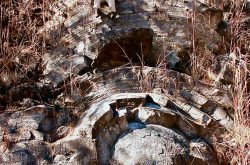
Oxygen first accumulated in the Earth’s atmosphere about 2.4 billion years ago, during the Great Oxidation Event. A long-standing puzzle has been that geologic clues suggest early bacteria were photosynthesizing and pumping out oxygen hundreds of millions of years before then. Where was it all going?
Something was holding back oxygen’s rise. A new interpretation of rocks billions of years old finds volcanic gases are the likely culprits. The study led by the University of Washington was published in June in the open-access journal Nature Communications.
“This study revives a classic hypothesis for the evolution of atmospheric oxygen,” said lead author Shintaro Kadoya, a UW postdoctoral researcher in Earth and space sciences. “The data demonstrates that an evolution of the mantle of the Earth could control an evolution of the atmosphere of the Earth, and possibly an evolution of life.”
Multicellular life needs a concentrated supply of oxygen, so the accumulation of oxygen is key to the evolution of oxygen-breathing life on Earth.
“If changes in the mantle controlled atmospheric oxygen, as this study suggests, the mantle might ultimately set a tempo of the evolution of life,” Kadoya said.
The new work builds on a 2019 paper that found the early Earth’s mantle was far less oxidized, or contained more substances that can react with oxygen, than the modern mantle. That study of ancient volcanic rocks, up to 3.55 billion years old, were collected from sites that included South Africa and Canada.
Read more at UW News »
